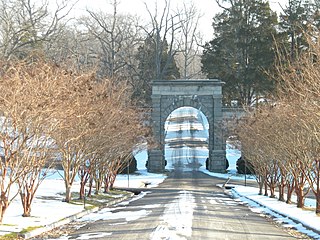
Blandford Cemetery is a historic cemetery located in Petersburg, Virginia. Although in recent years it has attained some notoriety for its large collection of more than 30,000 Confederate graves, it contains remains of people of all classes and races as well as veterans of every American war. It holds the largest mass grave of 30,000 Confederates killed in the Siege of Petersburg (1864–65) and other battles during the American Civil War. Although only 3,700 names of the interred are known, it was listed on the National Register of Historic Places in 1992, in part through the efforts of Charlotte Irving, first president of the Historic Blandford Cemetery Foundation. In addition to this cemetery's historic African American section discussed below, it is located adjacent to the People's Memorial Cemetery, a historic African-American cemetery, and small cemeteries containing additional dead from the lengthy Siege of Petersburg and Battle of the Crater in 1864.
Seven Pines National Cemetery is a national cemetery located in the Seven Pines area of the unincorporated town of Sandston in Henrico County, Virginia. Cemetery records state the name is derived from for a group of seven pine trees planted within the national cemetery in 1869 near the intersection of the old Williamsburg-Richmond Stage Road and the Nine Mile Road, however, the name Seven Pines pre-dates the establishment of the cemetery.
William Campbell was a Virginia farmer, pioneer, and soldier. One of the thirteen signers of the earliest statement of armed resistance to the British Crown in the Thirteen Colonies, the Fincastle Resolutions, Campbell represented Hanover County in the Virginia House of Delegates. A militia leader during the American Revolutionary War, he was known to Loyalists as the "bloody tyrant of Washington County", but to the Patriots he was known for his leadership at the Battle of Kings Mountain and the Battle of Guilford Courthouse.
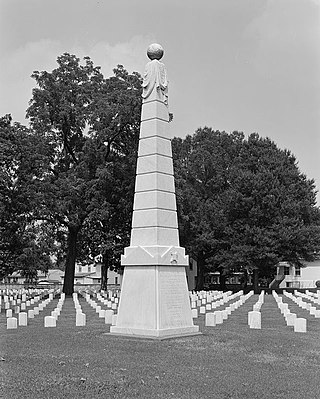
City Point National Cemetery is a United States National Cemetery in the community of City Point within the city of Hopewell, Virginia. Administered by the United States Department of Veterans Affairs, it encompasses 6.7 acres (2.7 ha), and as of the end of 2005, had 6,909 interments. It is managed by Hampton National Cemetery.
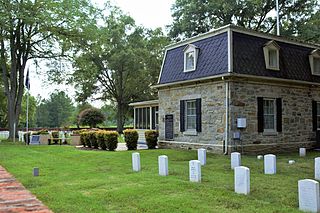
Fort Harrison National Cemetery is a United States National Cemetery located seven miles (11 km) south of the city of Richmond, in Henrico County, Virginia. Administered by the United States Department of Veterans Affairs, It encompasses 1.5 acres (0.61 ha), and as of the end of 2005, had 1,570 interments.

Leesylvania State Park is located in the southeastern part of Prince William County, Virginia. The land was donated in 1978 by philanthropist Daniel K. Ludwig, and the park was dedicated in 1985 and opened full-time in 1992.
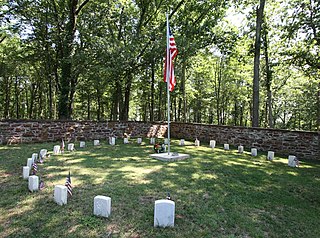
Ball's Bluff Battlefield Regional Park and National Cemetery is a battlefield area and a United States National Cemetery, located 2 miles (3.2 km) northeast of Leesburg, Virginia. The cemetery is the third smallest national cemetery in the United States. Fifty-four Union Army dead from the Battle of Ball's Bluff are interred in 25 graves in the half-acre plot; the identity of all of the interred except for one, James Allen of the 15th Massachusetts, are unknown. Monuments to fallen Confederate Sergeant Clinton Hatcher and Union brigade commander Edward Dickinson Baker are located next to the cemetery, though neither is buried there. While the stone wall-enclosed cemetery itself is managed through the Culpeper National Cemetery and owned by the Department of Veterans Affairs, the balance of the 223-acre (0.90 km2) park is managed through the Northern Virginia Regional Park Authority.
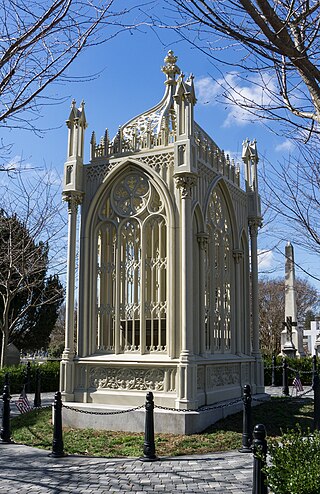
The James Monroe Tomb is the burial place of U.S. President James Monroe in Hollywood Cemetery, Richmond, Virginia, United States. The principal feature of the tomb is an architecturally unusual cast iron cage, designed by Albert Lybrock and installed in 1859 after Monroe's body was moved from Marble Cemetery in New York City. The tomb was declared a National Historic Landmark in 1971 for its unique architecture. To Richmonders it is colloquially known as The Birdcage.

Hickory Hill is an estate in Hanover County, Virginia. The 3,300 acre former plantation is located approximately 20 miles (32 km) north of the independent city of Richmond and 5 miles (8.0 km) east of the incorporated town of Ashland. The property was listed in the National Register of Historic Places and the Virginia Landmarks Register in 1974.

The Emek Sholom Holocaust Memorial Cemetery was built in 1955 and is located within Forest Lawn Cemetery in Richmond, Virginia. It was listed on the National Register of Historic Places in 1999. "Emek Sholom" translates into English as "Valley of Peace."

East Hill Cemetery, also known as Maryland Hill, Round Hill, Rooster Hill, and City Cemetery, is a historic cemetery located at Bristol, Virginia. It is an American Civil War-era cemetery established in 1857, with sections for Confederate soldiers and veterans as well as a small section for African American burials. In 1995, the United Daughters of the Confederacy put up a small commemorative monument to the Civil War dead. Among its graves are the founders of the city, representatives of enslaved African-Americans, Civil War soldiers including those who died as a result of the war as well as those who survived the war, a Revolutionary War General of Militia Evan Shelby, and many who have made contributions to Bristol and the nation. It straddles the Tennessee-Virginia border.

Fairview Cemetery, also known as Citizens' Cemetery and Antioch Cemetery, is a historic cemetery located at Culpeper, Culpeper County, Virginia, United States.
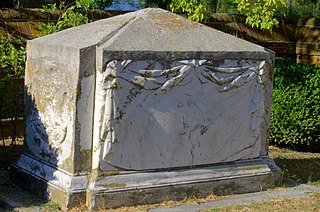
Custis Tombs, also known as Custis cemetery at Arlington, is a historic family burial ground located near Cheapside, Northampton County, Virginia. It consists of two tombs surrounded by a poured concrete platform raised a few inches above ground level. It includes the grave of John Custis, Major General and member of the Council for Virginia and progenitor of the Custis family in America. The other tomb is the box-like marble tomb of John Custis IV (1678–1749) with its pyramidal top and drapery carvings on the long sides. The tombs were associated with Arlington mansion and located west of the separately listed Arlington Archeological Site.
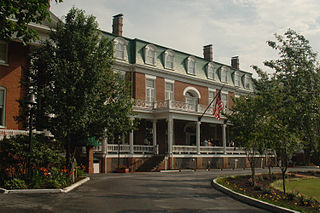
Abingdon Historic District is a national historic district located at Abingdon, Washington County, Virginia. The district encompasses 145 contributing buildings, 2 contributing site, and 13 contributing structures in the town of Abingdon. It includes a variety of residential, commercial, and institutional buildings dating from the late-18th century to the mid-20th century. Notable contributing resources include Sinking Spring Cemetery, William King High School (1913), General Francis Preston House (1832), Martha Washington Inn, Barter Theatre, the Virginia House, Alexander Findlay House (1827), Gabriel Stickley House, Ann Berry House, Washington County Courthouse (1868), Rev. Charles Cummings House, and James Fields House (1857). Located in the district and separately listed are the Abingdon Bank and Dr. William H. Pitts House.

Kimberling Lutheran Cemetery is a historic Lutheran cemetery and national historic district located near Rural Retreat, Wythe County, Virginia. The cemetery includes approximately about 50 early Germanic sandstone monuments dating from 1800 to 1850. The associated Kimberlin Lutheran Church was built in 1913, and is a large frame structure with two unequal-sized towers.

McGavock Family Cemetery is a historic family cemetery located near Fort Chiswell, Wythe County, Virginia. It is located on a hill above The Mansion at Fort Chiswell. The cemetery includes approximately about 15 Germanic sandstone monuments dating from 1812 to the late-1830s.
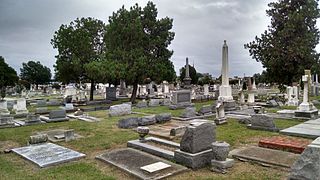
Cedar Grove Cemetery is a historic public cemetery located at Portsmouth, Virginia. It was established by an act of the Virginia General Assembly in 1832. The cemetery contains more than 400 graves with monuments dating from the late 1700s to the present. Its memorial markers include small tablets, ledger stones, obelisks, columnar monuments and mausoleums. They include notable examples of Greek Revival, Late Victorian, and Exotic Revival funerary art.
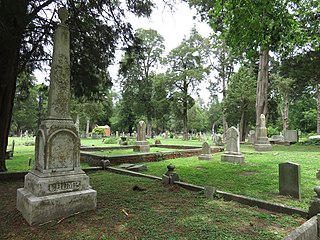
Cedar Hill Cemetery, also known as Green Hill Cemetery, is a historic cemetery and national historic district located at Suffolk, Virginia. The district encompasses four contributing structures, one contributing site, and three contributing objects in the a city-owned, 25-acre, public cemetery dating to 1802. Grave markers within the cemetery date from the early 19th century to the present day. This cemetery is a representative example of public cemetery planning and funerary artwork found in southeast Virginia and Suffolk. The contributing structures include the Darden (1938), Hosier, Hill (1933) and Brewer-Godwin mausoleums and the contributing objects include the Confederate Monument (1889) and World War I Monument.
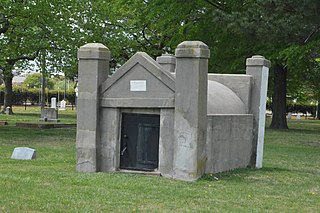
Elmwood Cemetery is a historic municipal cemetery located at Norfolk, Virginia. It was established in 1853, and is filled with monuments and mausoleums that embody the pathos and symbolism of the Christian view of death as a temporary sleep. A notable monument is the Recording Angel by William Couper (1853–1942) at the Couper Family plot. The Core Mausoleum (1910–1915) designed by Harold Van Buren Magonigle (1867–1935), with sculptures by Edward Field Sanford, Jr. (1886–1951), is another notable resource.
Leesylvania was a plantation and historic home in Prince William County, Virginia, now part of Leesylvania State Park. During the 18th century, it was the home of Henry Lee II, his family and numerous slaves, and known for its productive land and especially the quality of its tobacco. Lee's sons Henry "Light-Horse Harry" Lee, Richard Bland Lee and Charles Lee, held prominent positions in Virginia during the American Revolutionary War and early federal government.





















